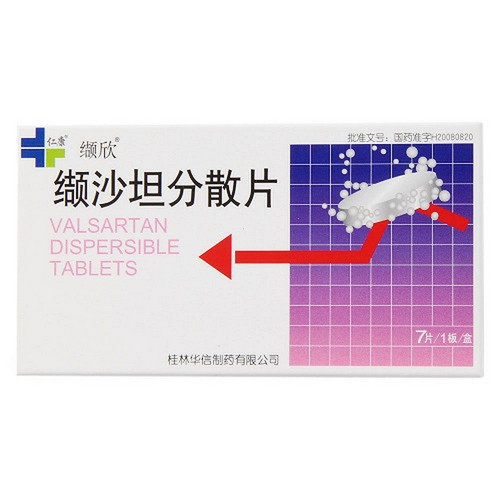Product Overview
[Drug Name]
Generic Name: Pinsartan Tablets
Trade Name: BeiZe ZuoShaTan Tablets 80mg*35 Tablets
Pinyin Full Code: BeiZe ZuoShaTanPian 80mg*35 Tablets
[Main Ingredient]
Active ingredient: Pinsartan
Chemical Name: (S)-N-Valeryl-N-{[2'-(1H-5-tetrazolyl)-4-diphenyl]methyl}-valine
Molecular Formula: C24H29N5O3
Molecular Weight: 435.5
[Properties]
This product is a film-coated tablet that appears white or off-white after removal of the coating.
[Indications/Main Functions]
Treatment of mild to moderate essential hypertension.
[Specifications]
80mg*35 tablets
[Dosage and Administration]
Recommended dose: 80mg once daily. Dosage is not affected by race, age, or gender. It can be taken with or without food (see [Pharmacokinetics]). It is recommended to take the drug at the same time each day (e.g., in the morning). A definitive antihypertensive effect is achieved within two weeks, and maximum efficacy is achieved after four weeks. If the antihypertensive effect is unsatisfactory, the daily dose can be increased to 160 mg, or a diuretic can be added. Elderly individuals generally do not require an adjustment in the starting dose. No adjustment in the starting dose is required for patients with mild to moderate renal impairment. For severe renal impairment (creatinine clearance <30 m/min), see [Contraindications]. No dose adjustment is required for patients with mild to moderate hepatic impairment of non-biliary origin and without cholestasis. No dose is recommended for patients with severe hepatic impairment. Patients with impaired hepatic or renal function require increased monitoring when using this drug. Valsartan can be used in combination with other antihypertensive drugs.
[Adverse Reactions]
See the package insert for details.
[Contraindications]
Allergy to valsartan or any of the other excipients in this drug. Pregnancy (see [Use in Pregnant and Lactating Women]). No data are currently available for use in patients with severe renal impairment (creatinine clearance <30 m/min). Do not use this drug with aliskiren in patients with diabetes.
[Precautions]
Fetus and Neonate: Use of drugs that directly act on the renin-angiotensin system during the second and third trimesters of pregnancy may impair renal function in the fetus and increase the risk of morbidity and mortality in the fetus and neonate. This may result in oligohydramnios, pulmonary hypoplasia, and skeletal abnormalities. Potential neonatal adverse reactions include: craniosynostosis, anuria, hypotension, renal failure, and death. This drug should be discontinued immediately upon detection of pregnancy. Hyponatremia and/or Hypovolemia: Rarely, patients with severe sodium and/or hypovolemia (e.g., those taking high-dose diuretics) may experience symptomatic hypotension when starting treatment with this drug. Hyponatremia and/or hypovolemia should be corrected before starting treatment, for example, by reducing the diuretic dose. If hypotension occurs, the patient should be placed in a supine position and, if necessary, given intravenous saline. Treatment with this drug can be continued after blood pressure stabilizes. Renal Artery Stenosis: Short-term use of this drug for 4 days in 12 patients with secondary renovascular hypertension due to unilateral renal artery stenosis did not cause significant changes in renal hemodynamics, creatinine, or blood urea nitrogen (BUN). Because other drugs that act on the renin-angiotensin-aldosterone system (RAAS) may increase BUN and creatinine in patients with unilateral or bilateral renal artery stenosis, monitoring BUN and creatinine is recommended as a safety measure. Renal Impairment: No initial dose adjustment is required in patients with mild to moderate renal impairment. Patients with renal impairment require increased monitoring when using this drug. There are no data on the use of this drug in patients with severe renal impairment (creatinine clearance <30 mI/min), and its use is not recommended (see [Contraindications]). This drug should not be used concomitantly with aliskiren in patients with diabetes. Avoid concomitant use of this drug with aliskiren in patients with impaired renal function (creatinine clearance <60 mI/min). Due to inhibition of the renin-angiotensin-aldosterone system (RAAS), changes in renal function may occur in susceptible individuals. Patients whose renal function may be partially dependent on RAS activity (e.g., renal artery stenosis, chronic renal impairment, severe congestive heart failure, or volume depletion) are at increased risk of acute renal injury (including acute renal failure) when using drugs that inhibit the RAAS, including valsartan. Renal function should be monitored regularly in such sensitive patients while using this drug. Hepatic Impairment: No dose adjustment is required for patients with mild to moderate hepatic impairment of non-biliary origin and without cholestasis. Valsartan is excreted primarily unchanged in the bile, with reduced excretion in patients with biliary obstruction (see Pharmacokinetics). This drug should be used with caution in patients with biliary obstruction and cholestasis. No dose recommendation is available for patients with severe hepatic impairment. Patients with hepatic impairment require increased monitoring when using this drug. Angioedema: Angioedema, including laryngeal and glottic edema, causing airway obstruction and/or swelling of the face, lips, pharynx, and/or tongue, has been reported in patients treated with valsartan; some of these patients have a history of angioedema with other medications, including ACE inhibitors. Patients who develop angioedema should immediately discontinue valsartan and avoid further use. Dual blockade of the renin-angiotensin-aldosterone system: Use angiotensin II receptor blockers (including valsartan) with ACE inhibitors or aliskiren with extreme caution. Blood pressure, renal function, and electrolytes should be closely monitored when this product is used in combination with other drugs that block the renin-angiotensin-aldosterone system.










